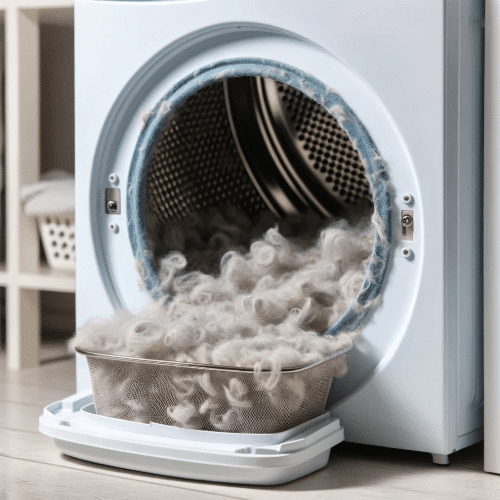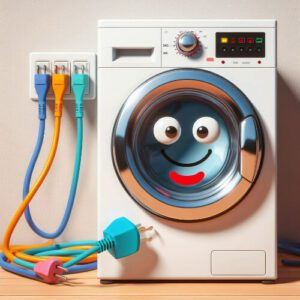Blog


Safety: Keep your dryer safe! Regularly cleaning and servicing it helps prevent fires. Lint builds up over time and can catch fire. By keeping your dryer clean, you’re keeping your home and family safe.
Efficiency and Performance: A clean dryer works better and faster. Lint and dust block the air, making it hard for your dryer to work well. Service your dryer to keep it running smoothly, dry clothes quicker, and save energy.
Extended Lifespan: Regular servicing means your dryer lasts longer. Fixing small problems early stops them from becoming big ones. This means your dryer won’t break down as much, saving you money and hassle.
Cost Savings: A well-kept dryer uses less electricity, which means lower bills. It dries clothes faster, saving time and energy. Plus, fixing problems early is cheaper than big repairs later.
Peace of Mind: Knowing your dryer is in good shape means less stress. Regular check-ups mean you can do laundry without worrying about breakdowns or dangers. Enjoy peace of mind with a well-maintained dryer.
Decreased Drying Performance: If clothes take longer to dry or aren’t fully dry, your dryer might need service. Lint buildup can block airflow, making the dryer work harder. A broken heating element might also cause poor drying. Don’t ignore these signs! Regular cleaning and servicing keep your dryer working well and your energy bills low.
Unusual Noises or Vibrations: Strange sounds or shaking mean something’s wrong. A bad belt or worn-out roller might be the cause. Fixing these early stops bigger problems later. For quieter, smoother running, check for loose parts or imbalances and get them fixed.
Overheating and Burning Odors: Overheating or a burning smell is serious. Blocked vents or faulty thermostats are often to blame. Clear out lint and get the dryer checked. This prevents fires and keeps your dryer safe.
Excessive Lint Accumulation: Too much lint is a fire risk and makes your dryer less efficient. Clean the lint trap and vent regularly. If lint keeps building up, your dryer needs a professional look. Proper maintenance prevents fires and keeps your dryer running right.
Failure to Start or Frequent Stopping: If your dryer won’t start or stops unexpectedly during a cycle, it’s a clear sign service is needed. This could be due to electrical issues, a faulty door latch, or a broken start switch. It’s important to address these problems quickly to prevent further damage. A professional can identify the cause and repair your dryer, ensuring it runs reliably and efficiently. Don’t ignore these frustrating signs; they indicate your dryer urgently requires servicing
If your dryer is slow or not drying well, something might be wrong. Often, it’s because of blocked airflow. Lint and dirt can clog your dryer’s vent or lint trap, making it hard for air to flow and heat up properly. This means clothes take longer to dry.
Sometimes, the heating part might be broken. If it doesn’t heat up right, your clothes stay damp.
Ignoring these problems can cost you more in energy bills and can ruin your clothes.
To fix this, regularly clean the lint trap and vent. This helps your dryer work better.
If cleaning doesn’t help, you might need a pro. We can find and fix the problem.
Quickly fixing your dryer can save you time and money. It helps your dryer last longer and work right.
If your dryer is making weird noises or shaking, it’s telling you something’s wrong. Don’t ignore these signs as they can cause bigger, expensive problems. Knowing why your dryer is noisy or shaky helps you fix it.
A common reason for noise is a bad belt. This belt turns the drum, and over time it can wear out or break, making squeaking or thumping sounds. If your dryer is noisy, check the belt and replace it if it’s old or broken.
Sometimes, the noise comes from old rollers or pulleys that help turn the drum. If they’re damaged, they make grinding or rattling sounds. These parts need replacing to make your dryer quiet again.
If your dryer is shaking a lot, it might be unbalanced. Too much clothes or unevenly placed items can make it wobble. Make sure to load it right and check if it’s sitting level.
If the noise or shaking doesn’t stop, you might need help from a pro. Our technicians can look inside your dryer and fix whatever is wrong.
Always pay attention to strange noises or shaking from your dryer. Fixing these issues early keeps your dryer working well and saves you from bigger repairs later.
If your dryer is too hot or smells like burning, act fast. These are serious warnings of danger and shouldn’t be ignored. Knowing why your dryer overheats or smells burnt helps you solve the problem.
Often, the issue is with a blocked exhaust system. Lint, small clothes, or debris can clog the vent or ducts, stopping air from flowing out. This makes the dryer too hot, which can break it or even start a fire. To prevent this, clean out lint regularly and make sure the exhaust path is clear.
A broken thermostat can also cause overheating. It’s supposed to control the heat, but if it’s faulty, the dryer might get too hot. A professional can check this and fix or replace it.
Never ignore a burning smell. It might mean lint or dirt is near the heater or in other parts, which can catch fire. If you smell something burning, turn off and unplug the dryer. Don’t use it until it’s fixed.
To handle overheating or burning smells, it’s best to call in a pro. Our repair technicians can look everything over, clean out clogs, and fix any parts. Regular check-ups and cleanings can stop overheating and keep your dryer safe.
Take any signs of overheating or burning smells seriously. Quick action can prevent fires and keep your dryer running safely.
Too much lint in your dryer can lead to several issues, such as less effective drying, longer drying times, and even the risk of fires. It’s important to know why lint piles up and what it means for the safety and efficiency of your dryer.
Lint, tiny fibers from your clothes, gets trapped by the dryer’s lint trap during a cycle. However, some lint can still slip through and gather in places like the dryer vent, which leads outside. When the vent gets clogged, it restricts the flow of air, making your dryer work harder and longer to dry clothes. This not only wastes energy but also increases the risk of overheating and fires. Cleaning out the vent regularly is a must to avoid these problems.
Lint can also build up in the lint trap itself, especially if it’s not cleaned out regularly. This blocks air flow and lengthens drying time, too. Lint can even gather in the drum or around the heating element, affecting your dryer’s performance and posing a fire risk. Regularly cleaning your dryer’s interior is important for safety and efficiency.
Here are some tips to keep lint at bay:
If you’re still seeing a lot of lint or your dryer isn’t working as well, it might be time to call in a professional. They can do a deep clean and fix any problems. Keeping up with these maintenance tasks will help your dryer run better, safer, and last longer.

When your dryer needs fixing, it’s important to get professional help quickly. Putting it off could lead to a fire. Experts know how to find and fix problems, making sure your dryer works right and safely. Appliance technicians can spot and sort out blocked vents, broken thermostats, or old parts that might cause overheating and fires. Trusting our pros means you can relax, knowing your dryer is in good hands. Getting it serviced on time keeps you and your home safe, and it makes your dryer last longer too, saving you money and trouble. For safety and peace of mind, always choose professional servicing for your dryer.
While it’s often best to have a professional handle your dryer, you can perform basic maintenance on the exterior part yourself. Here’s how to do it in six steps:
Keeping your dryer safe from fires is really important. Here are some simple ways to make it safer:
Clean the lint trap every time: After each load, clean out the lint trap. This stops too much lint from blocking the air.
Clean the vent and pipe once a year: Take out lint from the dryer vent and pipe yearly to keep air moving well.
Don’t stuff the dryer: Putting too many clothes in can make it too hot and create more lint. Dry smaller amounts instead.
Use metal ducts: Use metal ducts instead of plastic or foil ones. They’re safer and don’t catch lint as easily.
Keep the area clean: Regularly clean around your dryer to keep dust and lint away.
Put a smoke alarm near the laundry room: A smoke alarm can alert you fast if there’s a fire.
Never leave the dryer on when you’re out or asleep: Always stay nearby while it’s running in case something goes wrong.
Regular check-ups and fixing your dryer when needed are key to keeping it running well and safely. Watch out for the warning signs we talked about. Fixing issues early stops big problems later. If you don’t look after your dryer, it might not work well, use too much power, or even cause a fire. If you see any warning signs, act fast to fix your dryer. You might fix some problems yourself, or you might need a pro’s help. Keeping your dryer in good shape is important. That way, it’ll work well and last longer. And remember, if you’re unsure or the problem seems big, contact us. Our specialists have seem many broken dryers and deal with dryer problems daily and have seen all types of issues. We’ll schedule a service to make your dryer safe and efficient again. Just give us a call!

If you have concerns about your appliance’s performance, contact the professionals at ARNI Services, Appliance Repair, for a thorough diagnosis and repair service. – you can’t put a price tag on peace of mind.